Contemporary Financial and Integrated Reporting: A Comparative Study
VerifiedAdded on 2021/05/31
|18
|3308
|45
Report
AI Summary
This report provides a comprehensive analysis of contemporary financial and integrated reporting, focusing on a comparative study between BHP Billiton Limited and Rio Tinto. It begins with an introduction to the importance of financial statements and the regulatory framework in Australia. The core business operations of both companies are examined, highlighting their roles in the resource sector, followed by an industry analysis that assesses the growth and factors influencing the mining sector. The report then delves into the financial structures of BHP, including capital structure elements and key financial performance indicators such as revenue, assets, and cash flow. It details the key elements of financial performance, including assets like property, plant, and equipment (PPE) and intangible assets, referencing relevant accounting standards. The report also addresses voluntary disclosures made by both companies. Overall, the report provides a detailed overview of the financial reporting practices, accounting treatments, and regulatory compliance of these two major players in the resources industry.
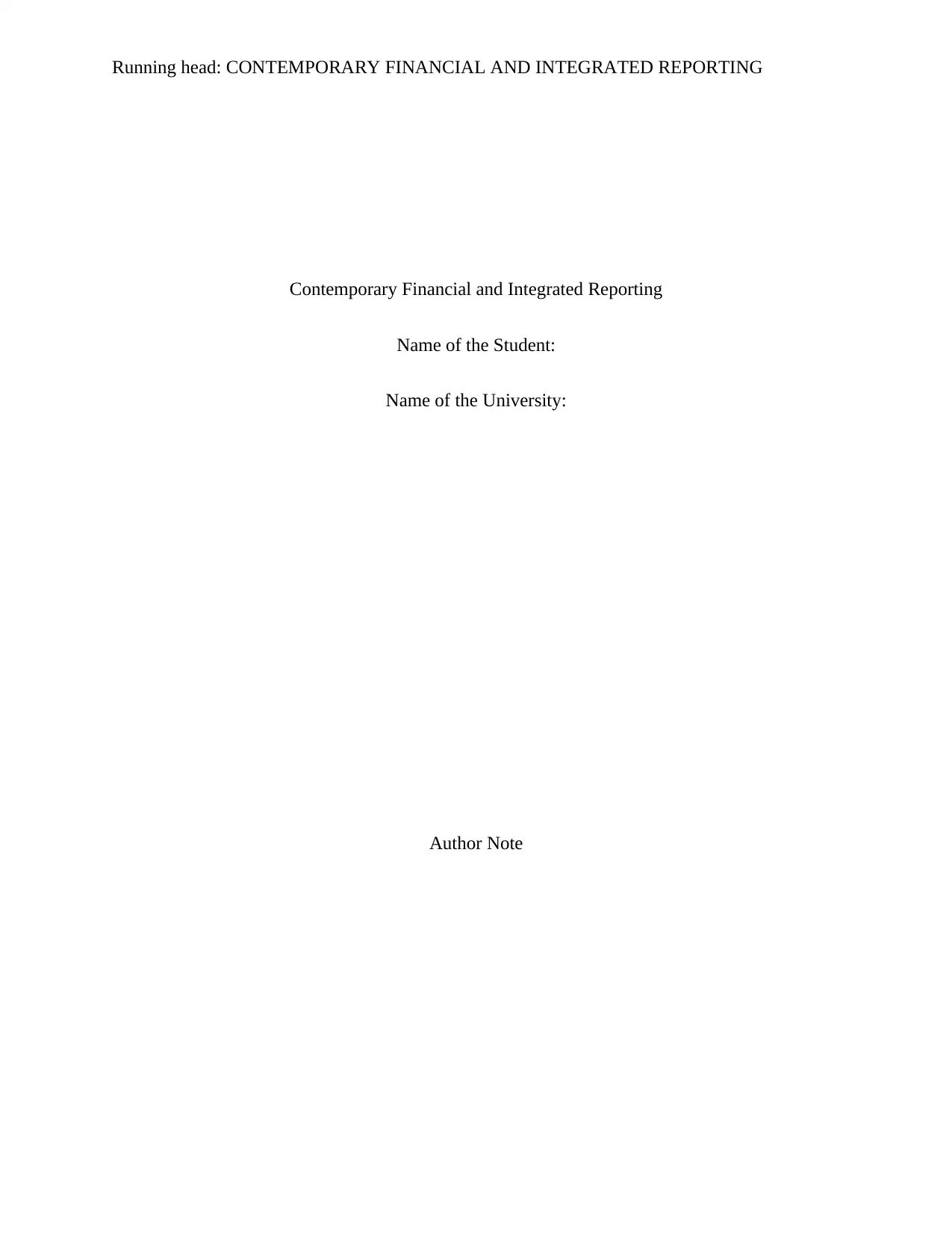
Running head: CONTEMPORARY FINANCIAL AND INTEGRATED REPORTING
Contemporary Financial and Integrated Reporting
Name of the Student:
Name of the University:
Author Note
Contemporary Financial and Integrated Reporting
Name of the Student:
Name of the University:
Author Note
Paraphrase This Document
Need a fresh take? Get an instant paraphrase of this document with our AI Paraphraser
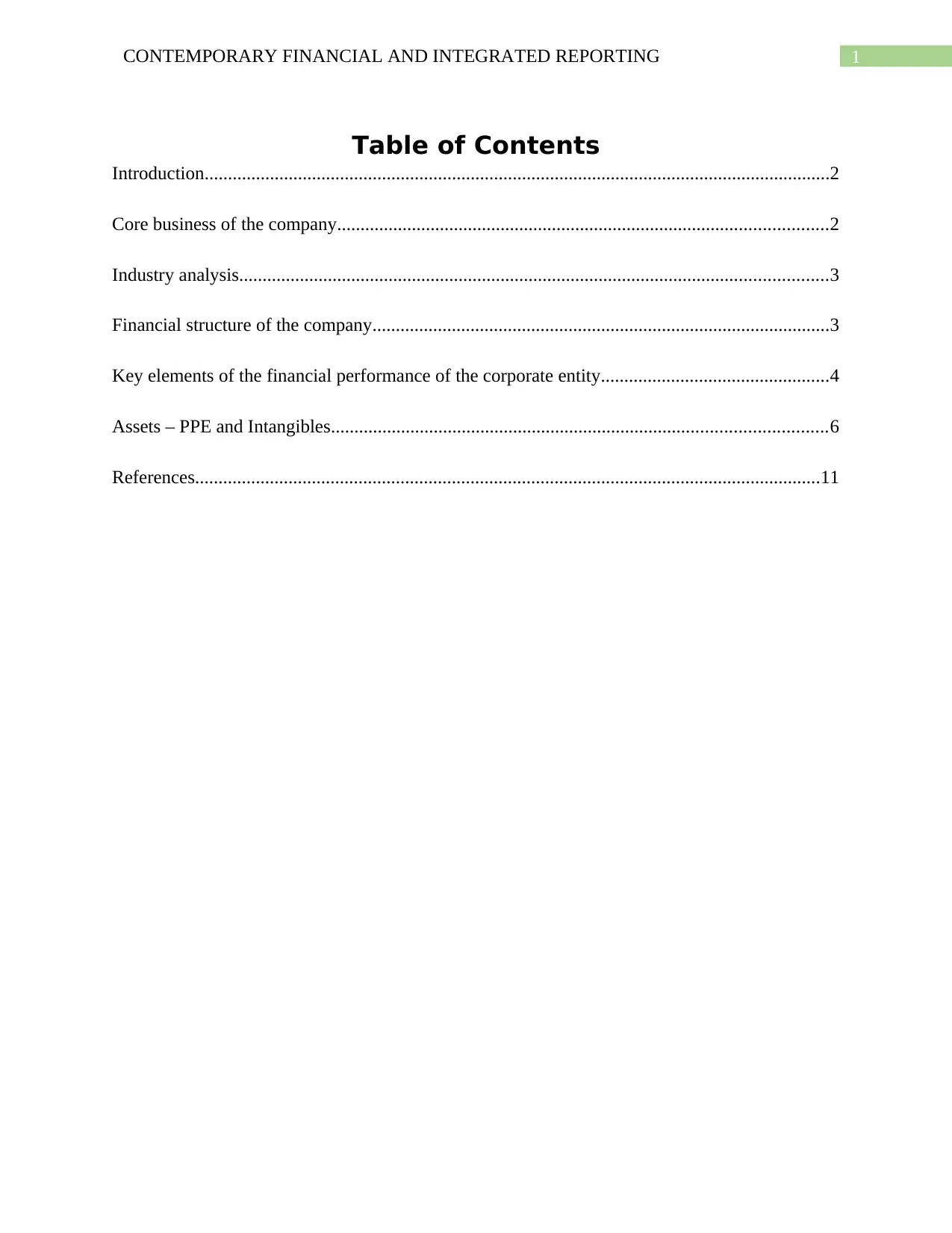
1CONTEMPORARY FINANCIAL AND INTEGRATED REPORTING
Table of Contents
Introduction......................................................................................................................................2
Core business of the company.........................................................................................................2
Industry analysis..............................................................................................................................3
Financial structure of the company..................................................................................................3
Key elements of the financial performance of the corporate entity.................................................4
Assets – PPE and Intangibles..........................................................................................................6
References......................................................................................................................................11
Table of Contents
Introduction......................................................................................................................................2
Core business of the company.........................................................................................................2
Industry analysis..............................................................................................................................3
Financial structure of the company..................................................................................................3
Key elements of the financial performance of the corporate entity.................................................4
Assets – PPE and Intangibles..........................................................................................................6
References......................................................................................................................................11
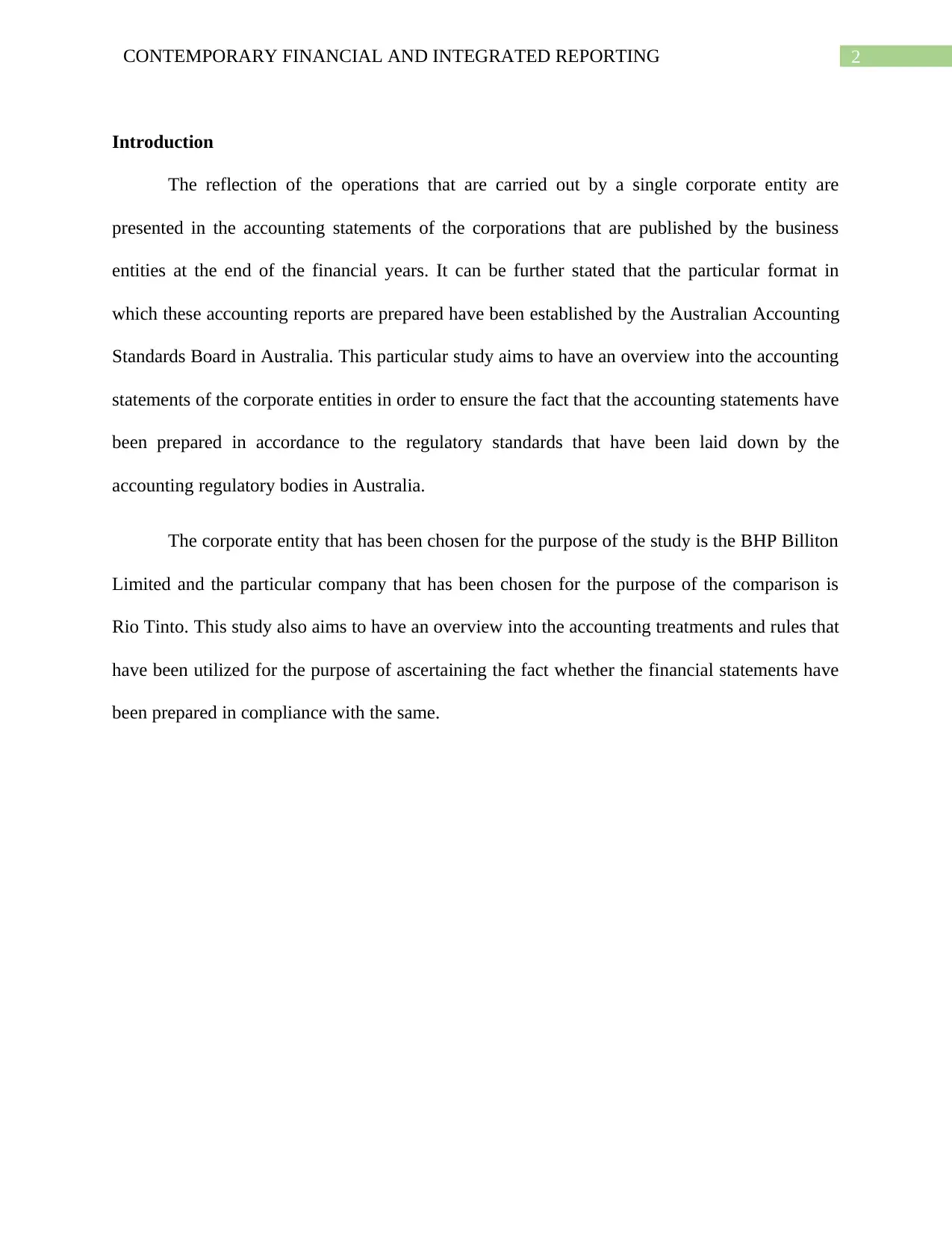
2CONTEMPORARY FINANCIAL AND INTEGRATED REPORTING
Introduction
The reflection of the operations that are carried out by a single corporate entity are
presented in the accounting statements of the corporations that are published by the business
entities at the end of the financial years. It can be further stated that the particular format in
which these accounting reports are prepared have been established by the Australian Accounting
Standards Board in Australia. This particular study aims to have an overview into the accounting
statements of the corporate entities in order to ensure the fact that the accounting statements have
been prepared in accordance to the regulatory standards that have been laid down by the
accounting regulatory bodies in Australia.
The corporate entity that has been chosen for the purpose of the study is the BHP Billiton
Limited and the particular company that has been chosen for the purpose of the comparison is
Rio Tinto. This study also aims to have an overview into the accounting treatments and rules that
have been utilized for the purpose of ascertaining the fact whether the financial statements have
been prepared in compliance with the same.
Introduction
The reflection of the operations that are carried out by a single corporate entity are
presented in the accounting statements of the corporations that are published by the business
entities at the end of the financial years. It can be further stated that the particular format in
which these accounting reports are prepared have been established by the Australian Accounting
Standards Board in Australia. This particular study aims to have an overview into the accounting
statements of the corporate entities in order to ensure the fact that the accounting statements have
been prepared in accordance to the regulatory standards that have been laid down by the
accounting regulatory bodies in Australia.
The corporate entity that has been chosen for the purpose of the study is the BHP Billiton
Limited and the particular company that has been chosen for the purpose of the comparison is
Rio Tinto. This study also aims to have an overview into the accounting treatments and rules that
have been utilized for the purpose of ascertaining the fact whether the financial statements have
been prepared in compliance with the same.
⊘ This is a preview!⊘
Do you want full access?
Subscribe today to unlock all pages.

Trusted by 1+ million students worldwide
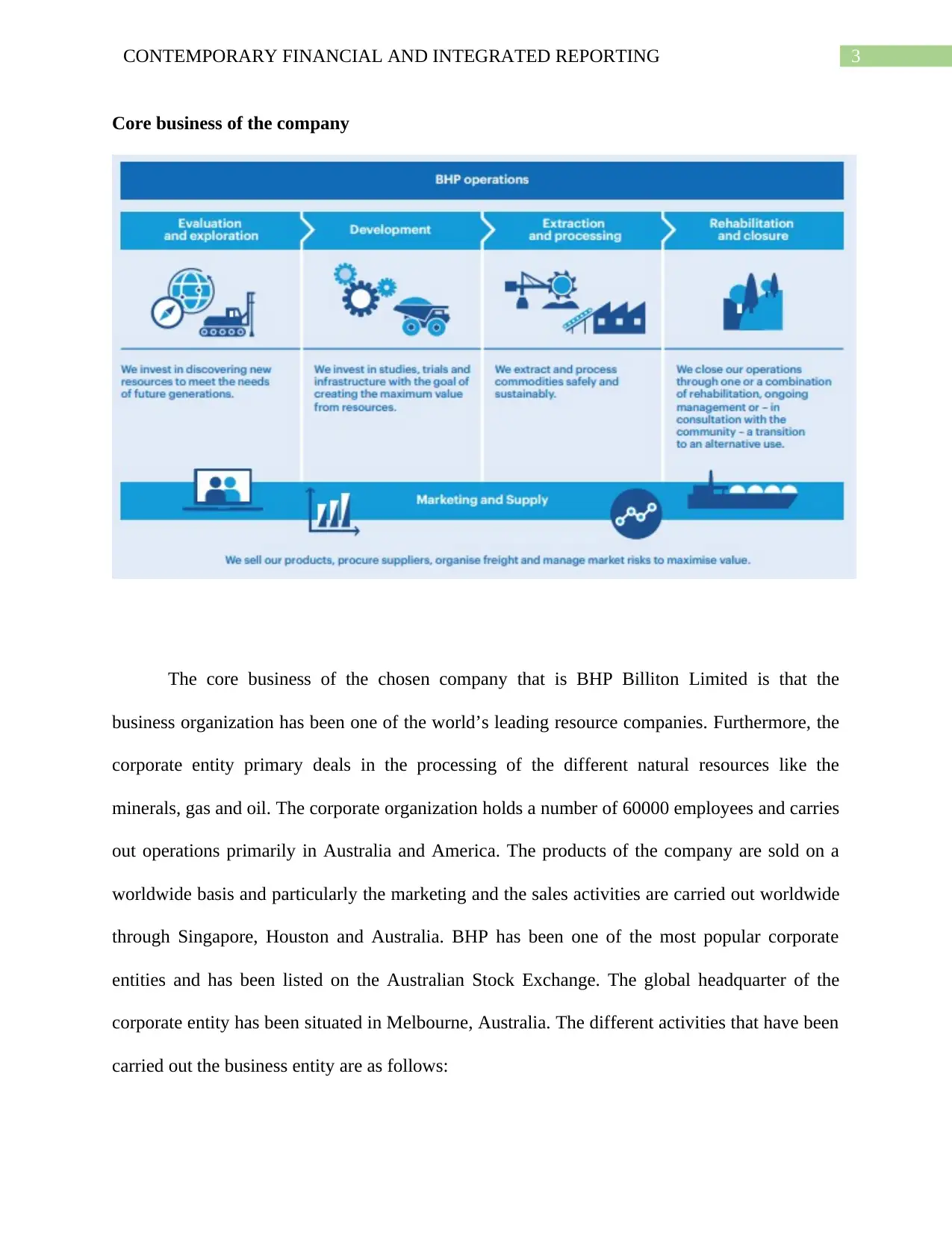
3CONTEMPORARY FINANCIAL AND INTEGRATED REPORTING
Core business of the company
The core business of the chosen company that is BHP Billiton Limited is that the
business organization has been one of the world’s leading resource companies. Furthermore, the
corporate entity primary deals in the processing of the different natural resources like the
minerals, gas and oil. The corporate organization holds a number of 60000 employees and carries
out operations primarily in Australia and America. The products of the company are sold on a
worldwide basis and particularly the marketing and the sales activities are carried out worldwide
through Singapore, Houston and Australia. BHP has been one of the most popular corporate
entities and has been listed on the Australian Stock Exchange. The global headquarter of the
corporate entity has been situated in Melbourne, Australia. The different activities that have been
carried out the business entity are as follows:
Core business of the company
The core business of the chosen company that is BHP Billiton Limited is that the
business organization has been one of the world’s leading resource companies. Furthermore, the
corporate entity primary deals in the processing of the different natural resources like the
minerals, gas and oil. The corporate organization holds a number of 60000 employees and carries
out operations primarily in Australia and America. The products of the company are sold on a
worldwide basis and particularly the marketing and the sales activities are carried out worldwide
through Singapore, Houston and Australia. BHP has been one of the most popular corporate
entities and has been listed on the Australian Stock Exchange. The global headquarter of the
corporate entity has been situated in Melbourne, Australia. The different activities that have been
carried out the business entity are as follows:
Paraphrase This Document
Need a fresh take? Get an instant paraphrase of this document with our AI Paraphraser
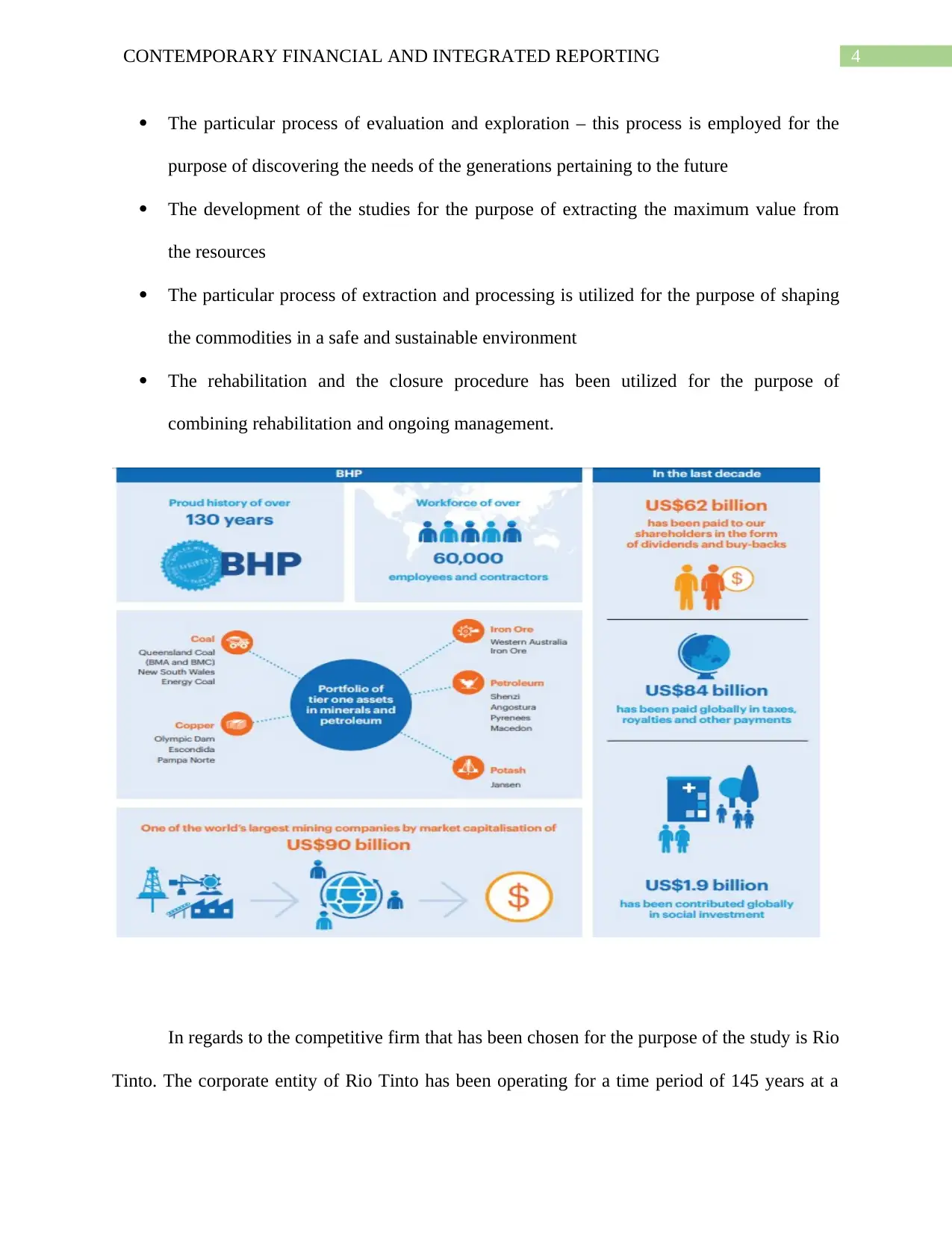
4CONTEMPORARY FINANCIAL AND INTEGRATED REPORTING
The particular process of evaluation and exploration – this process is employed for the
purpose of discovering the needs of the generations pertaining to the future
The development of the studies for the purpose of extracting the maximum value from
the resources
The particular process of extraction and processing is utilized for the purpose of shaping
the commodities in a safe and sustainable environment
The rehabilitation and the closure procedure has been utilized for the purpose of
combining rehabilitation and ongoing management.
In regards to the competitive firm that has been chosen for the purpose of the study is Rio
Tinto. The corporate entity of Rio Tinto has been operating for a time period of 145 years at a
The particular process of evaluation and exploration – this process is employed for the
purpose of discovering the needs of the generations pertaining to the future
The development of the studies for the purpose of extracting the maximum value from
the resources
The particular process of extraction and processing is utilized for the purpose of shaping
the commodities in a safe and sustainable environment
The rehabilitation and the closure procedure has been utilized for the purpose of
combining rehabilitation and ongoing management.
In regards to the competitive firm that has been chosen for the purpose of the study is Rio
Tinto. The corporate entity of Rio Tinto has been operating for a time period of 145 years at a
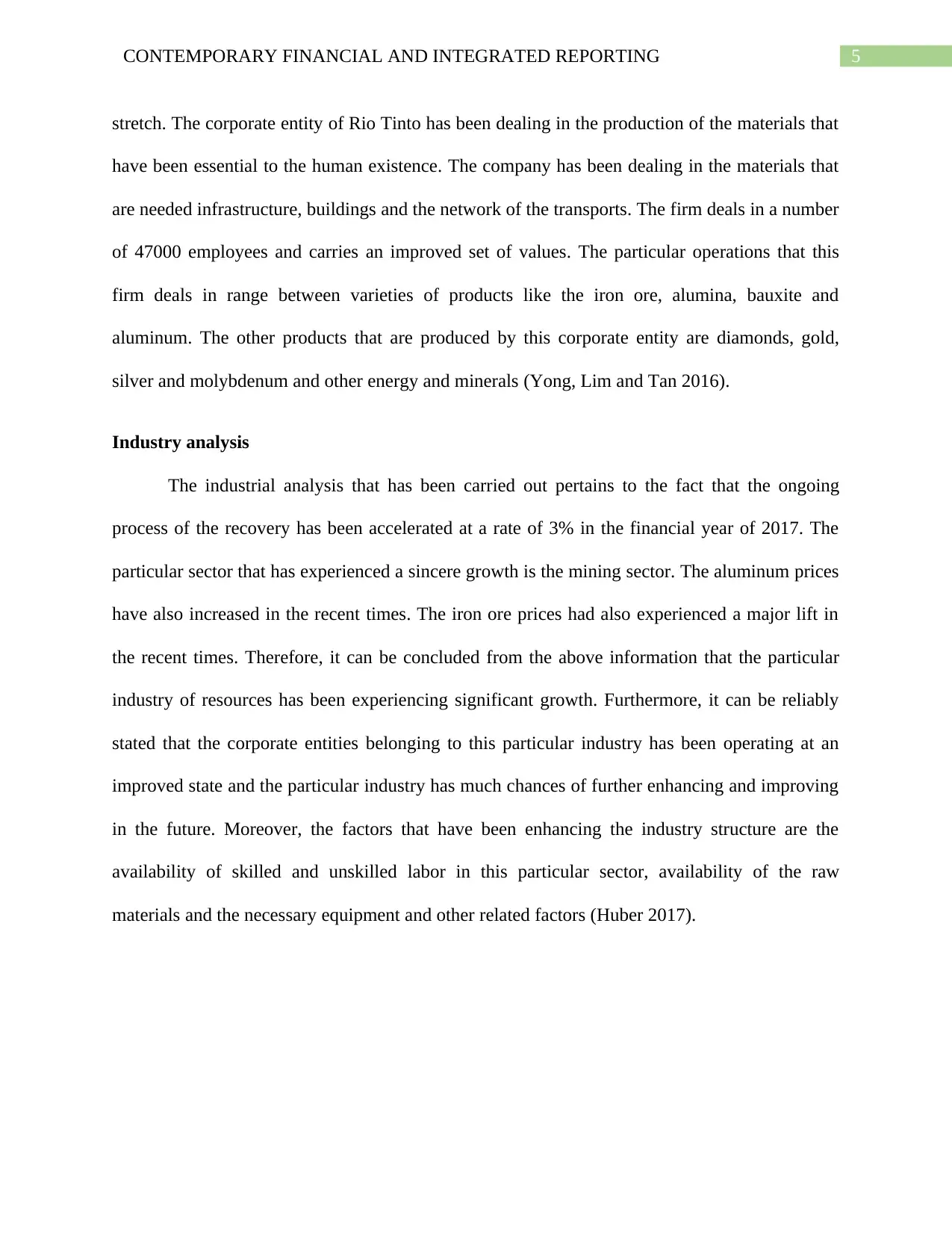
5CONTEMPORARY FINANCIAL AND INTEGRATED REPORTING
stretch. The corporate entity of Rio Tinto has been dealing in the production of the materials that
have been essential to the human existence. The company has been dealing in the materials that
are needed infrastructure, buildings and the network of the transports. The firm deals in a number
of 47000 employees and carries an improved set of values. The particular operations that this
firm deals in range between varieties of products like the iron ore, alumina, bauxite and
aluminum. The other products that are produced by this corporate entity are diamonds, gold,
silver and molybdenum and other energy and minerals (Yong, Lim and Tan 2016).
Industry analysis
The industrial analysis that has been carried out pertains to the fact that the ongoing
process of the recovery has been accelerated at a rate of 3% in the financial year of 2017. The
particular sector that has experienced a sincere growth is the mining sector. The aluminum prices
have also increased in the recent times. The iron ore prices had also experienced a major lift in
the recent times. Therefore, it can be concluded from the above information that the particular
industry of resources has been experiencing significant growth. Furthermore, it can be reliably
stated that the corporate entities belonging to this particular industry has been operating at an
improved state and the particular industry has much chances of further enhancing and improving
in the future. Moreover, the factors that have been enhancing the industry structure are the
availability of skilled and unskilled labor in this particular sector, availability of the raw
materials and the necessary equipment and other related factors (Huber 2017).
stretch. The corporate entity of Rio Tinto has been dealing in the production of the materials that
have been essential to the human existence. The company has been dealing in the materials that
are needed infrastructure, buildings and the network of the transports. The firm deals in a number
of 47000 employees and carries an improved set of values. The particular operations that this
firm deals in range between varieties of products like the iron ore, alumina, bauxite and
aluminum. The other products that are produced by this corporate entity are diamonds, gold,
silver and molybdenum and other energy and minerals (Yong, Lim and Tan 2016).
Industry analysis
The industrial analysis that has been carried out pertains to the fact that the ongoing
process of the recovery has been accelerated at a rate of 3% in the financial year of 2017. The
particular sector that has experienced a sincere growth is the mining sector. The aluminum prices
have also increased in the recent times. The iron ore prices had also experienced a major lift in
the recent times. Therefore, it can be concluded from the above information that the particular
industry of resources has been experiencing significant growth. Furthermore, it can be reliably
stated that the corporate entities belonging to this particular industry has been operating at an
improved state and the particular industry has much chances of further enhancing and improving
in the future. Moreover, the factors that have been enhancing the industry structure are the
availability of skilled and unskilled labor in this particular sector, availability of the raw
materials and the necessary equipment and other related factors (Huber 2017).
⊘ This is a preview!⊘
Do you want full access?
Subscribe today to unlock all pages.

Trusted by 1+ million students worldwide
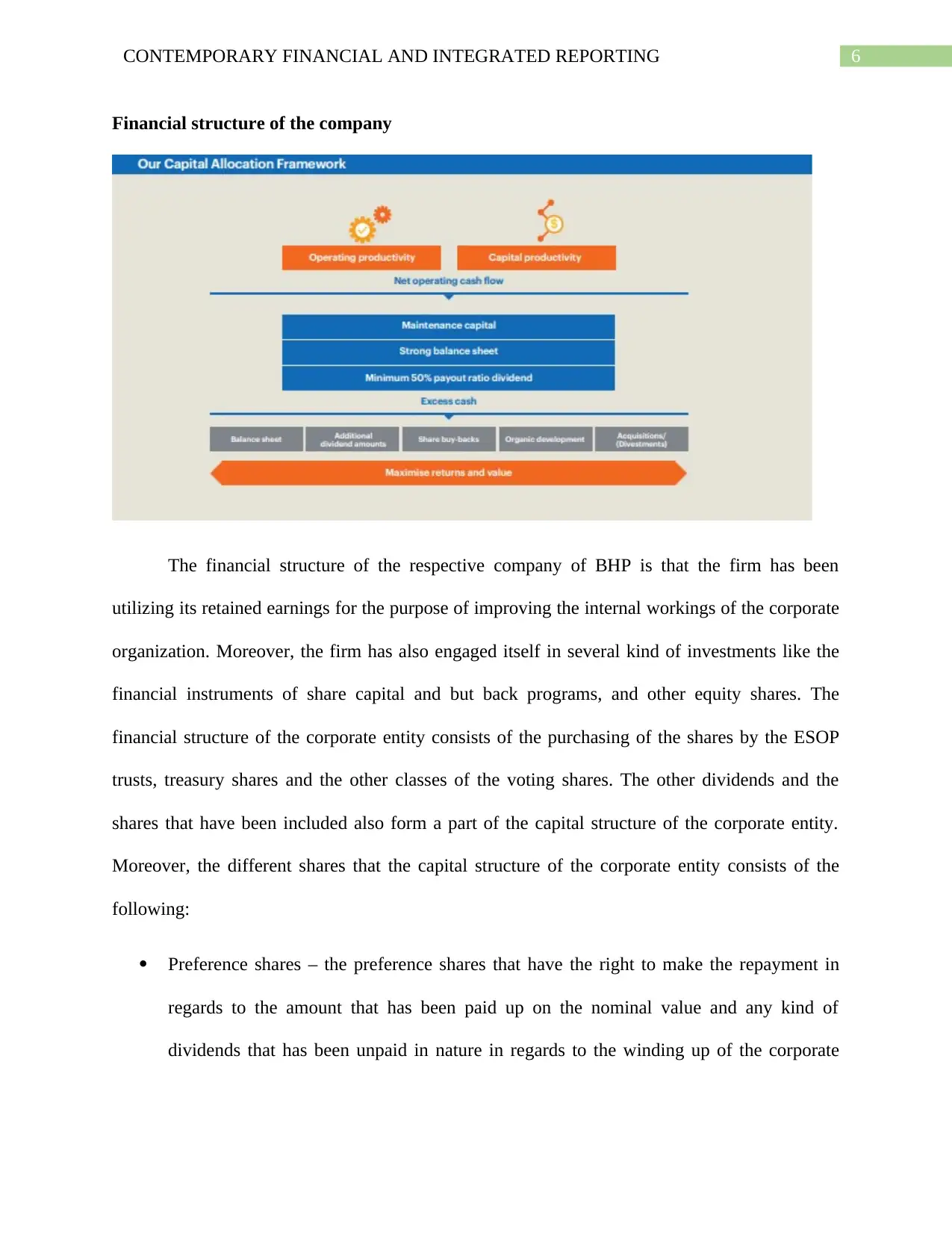
6CONTEMPORARY FINANCIAL AND INTEGRATED REPORTING
Financial structure of the company
The financial structure of the respective company of BHP is that the firm has been
utilizing its retained earnings for the purpose of improving the internal workings of the corporate
organization. Moreover, the firm has also engaged itself in several kind of investments like the
financial instruments of share capital and but back programs, and other equity shares. The
financial structure of the corporate entity consists of the purchasing of the shares by the ESOP
trusts, treasury shares and the other classes of the voting shares. The other dividends and the
shares that have been included also form a part of the capital structure of the corporate entity.
Moreover, the different shares that the capital structure of the corporate entity consists of the
following:
Preference shares – the preference shares that have the right to make the repayment in
regards to the amount that has been paid up on the nominal value and any kind of
dividends that has been unpaid in nature in regards to the winding up of the corporate
Financial structure of the company
The financial structure of the respective company of BHP is that the firm has been
utilizing its retained earnings for the purpose of improving the internal workings of the corporate
organization. Moreover, the firm has also engaged itself in several kind of investments like the
financial instruments of share capital and but back programs, and other equity shares. The
financial structure of the corporate entity consists of the purchasing of the shares by the ESOP
trusts, treasury shares and the other classes of the voting shares. The other dividends and the
shares that have been included also form a part of the capital structure of the corporate entity.
Moreover, the different shares that the capital structure of the corporate entity consists of the
following:
Preference shares – the preference shares that have the right to make the repayment in
regards to the amount that has been paid up on the nominal value and any kind of
dividends that has been unpaid in nature in regards to the winding up of the corporate
Paraphrase This Document
Need a fresh take? Get an instant paraphrase of this document with our AI Paraphraser
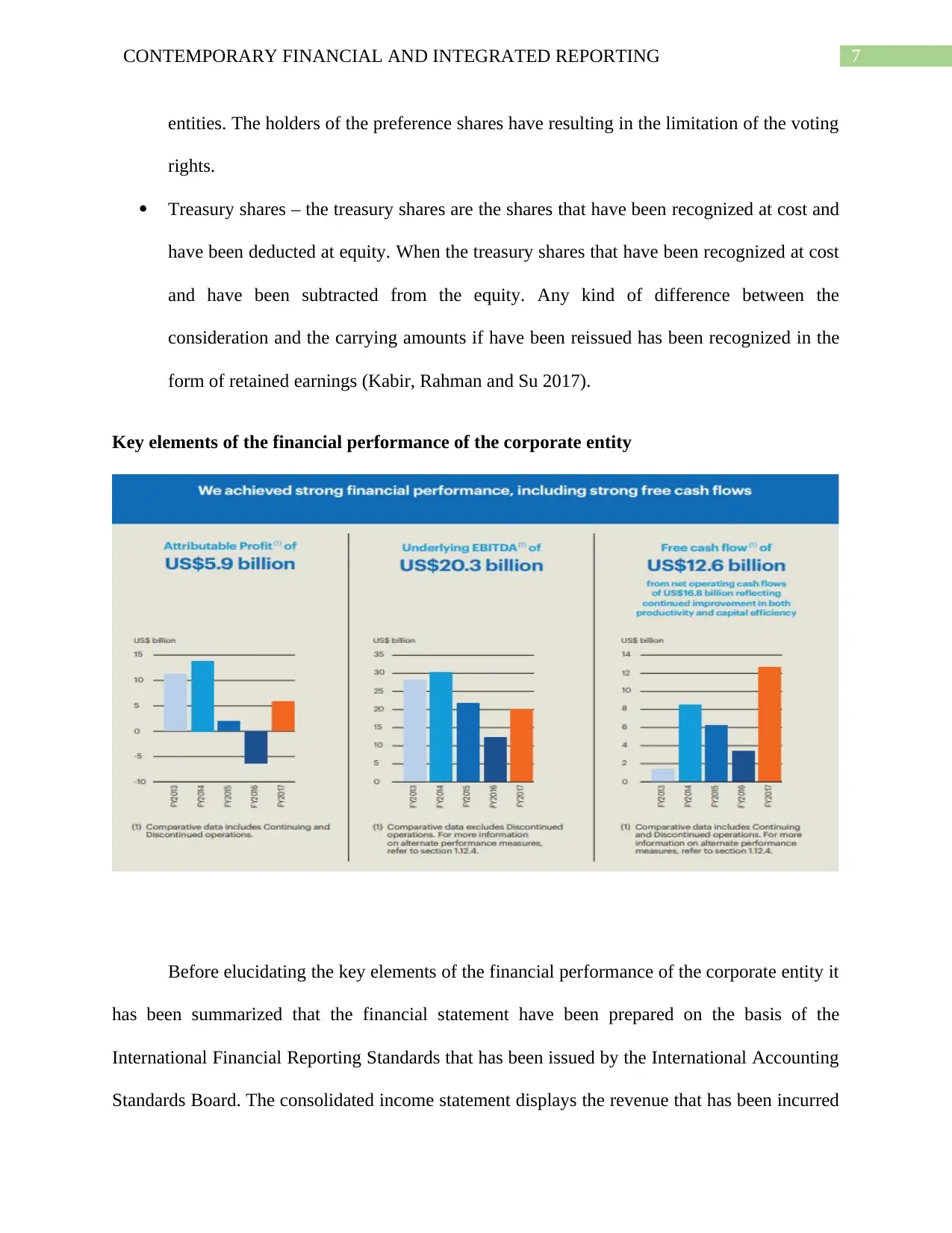
7CONTEMPORARY FINANCIAL AND INTEGRATED REPORTING
entities. The holders of the preference shares have resulting in the limitation of the voting
rights.
Treasury shares – the treasury shares are the shares that have been recognized at cost and
have been deducted at equity. When the treasury shares that have been recognized at cost
and have been subtracted from the equity. Any kind of difference between the
consideration and the carrying amounts if have been reissued has been recognized in the
form of retained earnings (Kabir, Rahman and Su 2017).
Key elements of the financial performance of the corporate entity
Before elucidating the key elements of the financial performance of the corporate entity it
has been summarized that the financial statement have been prepared on the basis of the
International Financial Reporting Standards that has been issued by the International Accounting
Standards Board. The consolidated income statement displays the revenue that has been incurred
entities. The holders of the preference shares have resulting in the limitation of the voting
rights.
Treasury shares – the treasury shares are the shares that have been recognized at cost and
have been deducted at equity. When the treasury shares that have been recognized at cost
and have been subtracted from the equity. Any kind of difference between the
consideration and the carrying amounts if have been reissued has been recognized in the
form of retained earnings (Kabir, Rahman and Su 2017).
Key elements of the financial performance of the corporate entity
Before elucidating the key elements of the financial performance of the corporate entity it
has been summarized that the financial statement have been prepared on the basis of the
International Financial Reporting Standards that has been issued by the International Accounting
Standards Board. The consolidated income statement displays the revenue that has been incurred
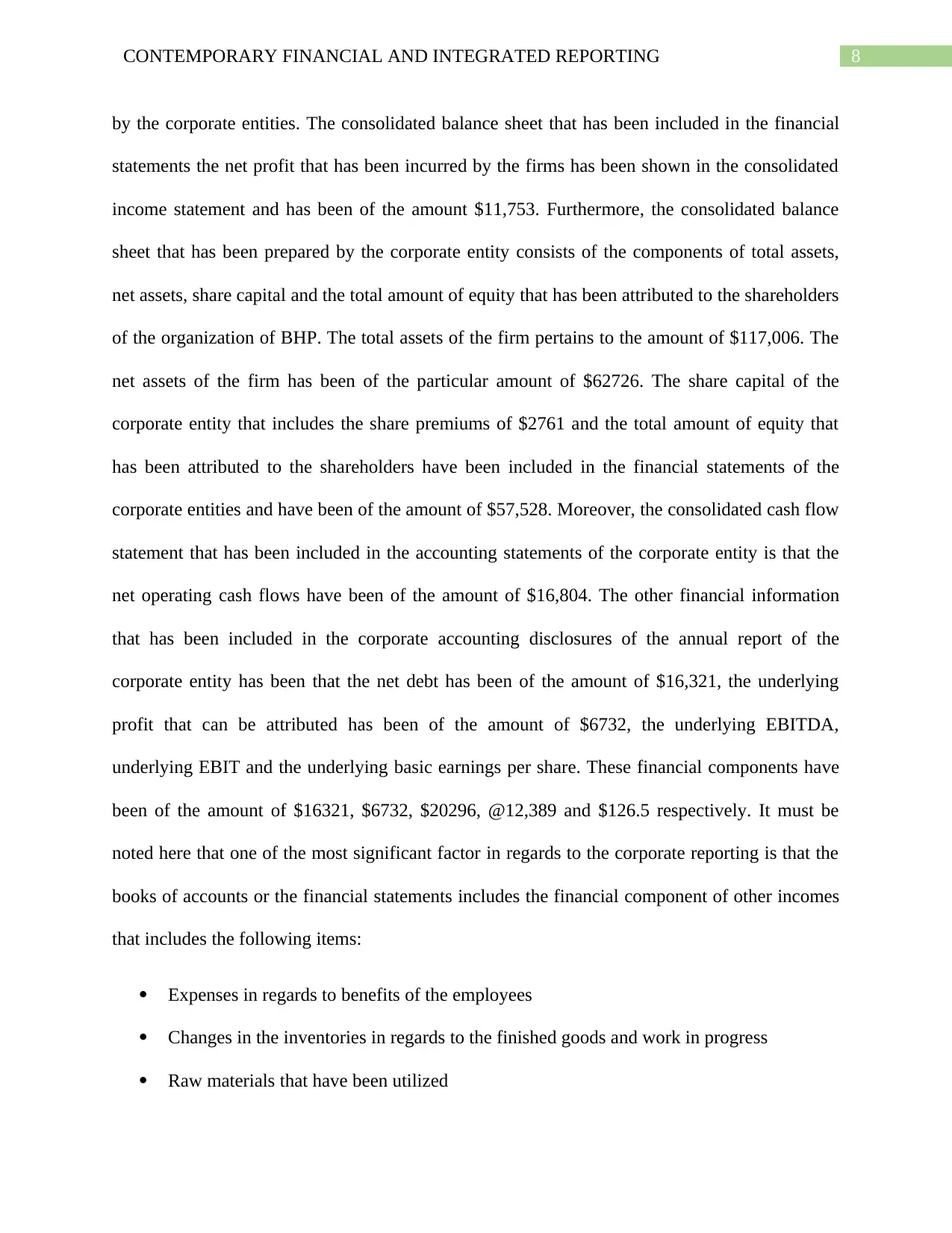
8CONTEMPORARY FINANCIAL AND INTEGRATED REPORTING
by the corporate entities. The consolidated balance sheet that has been included in the financial
statements the net profit that has been incurred by the firms has been shown in the consolidated
income statement and has been of the amount $11,753. Furthermore, the consolidated balance
sheet that has been prepared by the corporate entity consists of the components of total assets,
net assets, share capital and the total amount of equity that has been attributed to the shareholders
of the organization of BHP. The total assets of the firm pertains to the amount of $117,006. The
net assets of the firm has been of the particular amount of $62726. The share capital of the
corporate entity that includes the share premiums of $2761 and the total amount of equity that
has been attributed to the shareholders have been included in the financial statements of the
corporate entities and have been of the amount of $57,528. Moreover, the consolidated cash flow
statement that has been included in the accounting statements of the corporate entity is that the
net operating cash flows have been of the amount of $16,804. The other financial information
that has been included in the corporate accounting disclosures of the annual report of the
corporate entity has been that the net debt has been of the amount of $16,321, the underlying
profit that can be attributed has been of the amount of $6732, the underlying EBITDA,
underlying EBIT and the underlying basic earnings per share. These financial components have
been of the amount of $16321, $6732, $20296, @12,389 and $126.5 respectively. It must be
noted here that one of the most significant factor in regards to the corporate reporting is that the
books of accounts or the financial statements includes the financial component of other incomes
that includes the following items:
Expenses in regards to benefits of the employees
Changes in the inventories in regards to the finished goods and work in progress
Raw materials that have been utilized
by the corporate entities. The consolidated balance sheet that has been included in the financial
statements the net profit that has been incurred by the firms has been shown in the consolidated
income statement and has been of the amount $11,753. Furthermore, the consolidated balance
sheet that has been prepared by the corporate entity consists of the components of total assets,
net assets, share capital and the total amount of equity that has been attributed to the shareholders
of the organization of BHP. The total assets of the firm pertains to the amount of $117,006. The
net assets of the firm has been of the particular amount of $62726. The share capital of the
corporate entity that includes the share premiums of $2761 and the total amount of equity that
has been attributed to the shareholders have been included in the financial statements of the
corporate entities and have been of the amount of $57,528. Moreover, the consolidated cash flow
statement that has been included in the accounting statements of the corporate entity is that the
net operating cash flows have been of the amount of $16,804. The other financial information
that has been included in the corporate accounting disclosures of the annual report of the
corporate entity has been that the net debt has been of the amount of $16,321, the underlying
profit that can be attributed has been of the amount of $6732, the underlying EBITDA,
underlying EBIT and the underlying basic earnings per share. These financial components have
been of the amount of $16321, $6732, $20296, @12,389 and $126.5 respectively. It must be
noted here that one of the most significant factor in regards to the corporate reporting is that the
books of accounts or the financial statements includes the financial component of other incomes
that includes the following items:
Expenses in regards to benefits of the employees
Changes in the inventories in regards to the finished goods and work in progress
Raw materials that have been utilized
⊘ This is a preview!⊘
Do you want full access?
Subscribe today to unlock all pages.

Trusted by 1+ million students worldwide
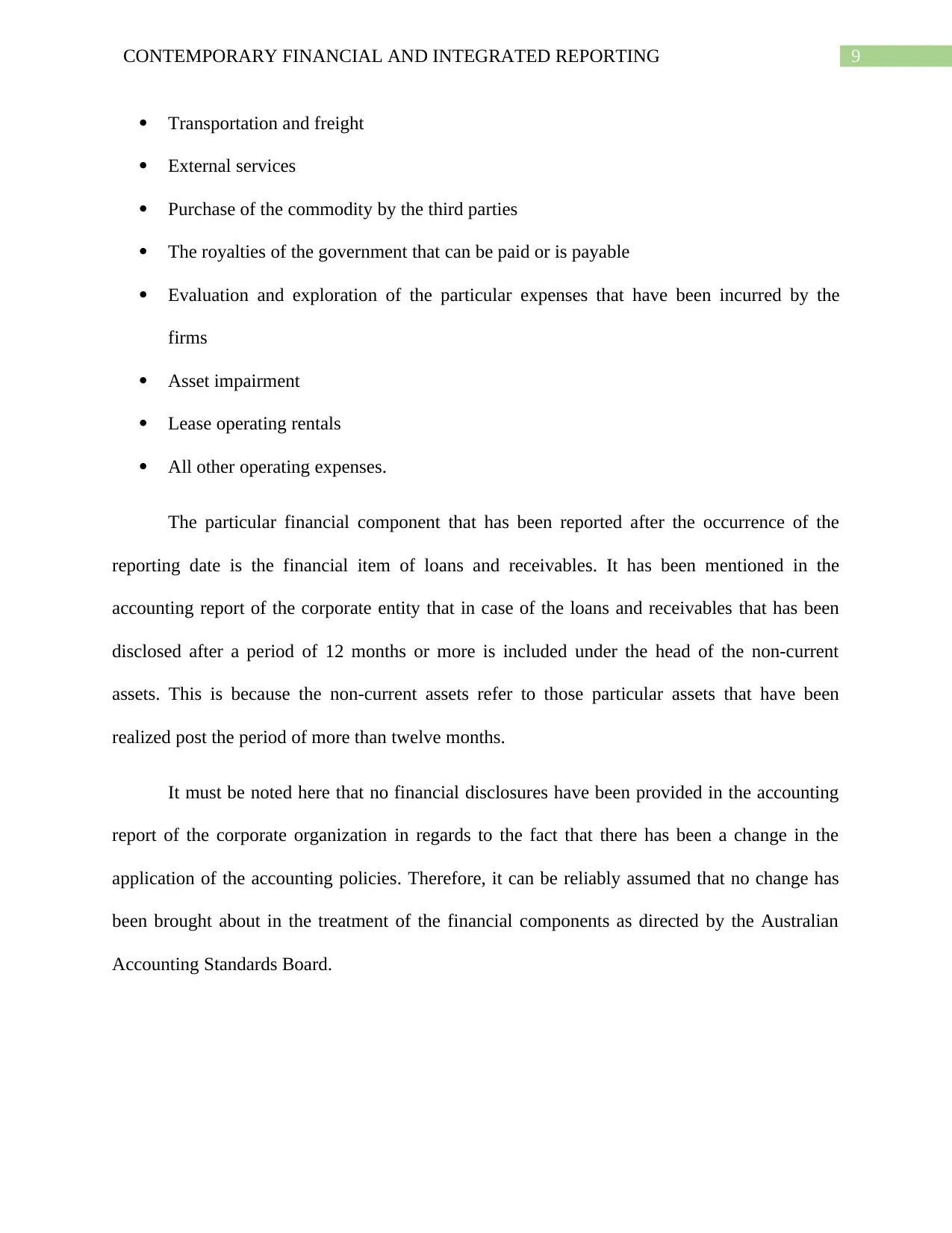
9CONTEMPORARY FINANCIAL AND INTEGRATED REPORTING
Transportation and freight
External services
Purchase of the commodity by the third parties
The royalties of the government that can be paid or is payable
Evaluation and exploration of the particular expenses that have been incurred by the
firms
Asset impairment
Lease operating rentals
All other operating expenses.
The particular financial component that has been reported after the occurrence of the
reporting date is the financial item of loans and receivables. It has been mentioned in the
accounting report of the corporate entity that in case of the loans and receivables that has been
disclosed after a period of 12 months or more is included under the head of the non-current
assets. This is because the non-current assets refer to those particular assets that have been
realized post the period of more than twelve months.
It must be noted here that no financial disclosures have been provided in the accounting
report of the corporate organization in regards to the fact that there has been a change in the
application of the accounting policies. Therefore, it can be reliably assumed that no change has
been brought about in the treatment of the financial components as directed by the Australian
Accounting Standards Board.
Transportation and freight
External services
Purchase of the commodity by the third parties
The royalties of the government that can be paid or is payable
Evaluation and exploration of the particular expenses that have been incurred by the
firms
Asset impairment
Lease operating rentals
All other operating expenses.
The particular financial component that has been reported after the occurrence of the
reporting date is the financial item of loans and receivables. It has been mentioned in the
accounting report of the corporate entity that in case of the loans and receivables that has been
disclosed after a period of 12 months or more is included under the head of the non-current
assets. This is because the non-current assets refer to those particular assets that have been
realized post the period of more than twelve months.
It must be noted here that no financial disclosures have been provided in the accounting
report of the corporate organization in regards to the fact that there has been a change in the
application of the accounting policies. Therefore, it can be reliably assumed that no change has
been brought about in the treatment of the financial components as directed by the Australian
Accounting Standards Board.
Paraphrase This Document
Need a fresh take? Get an instant paraphrase of this document with our AI Paraphraser
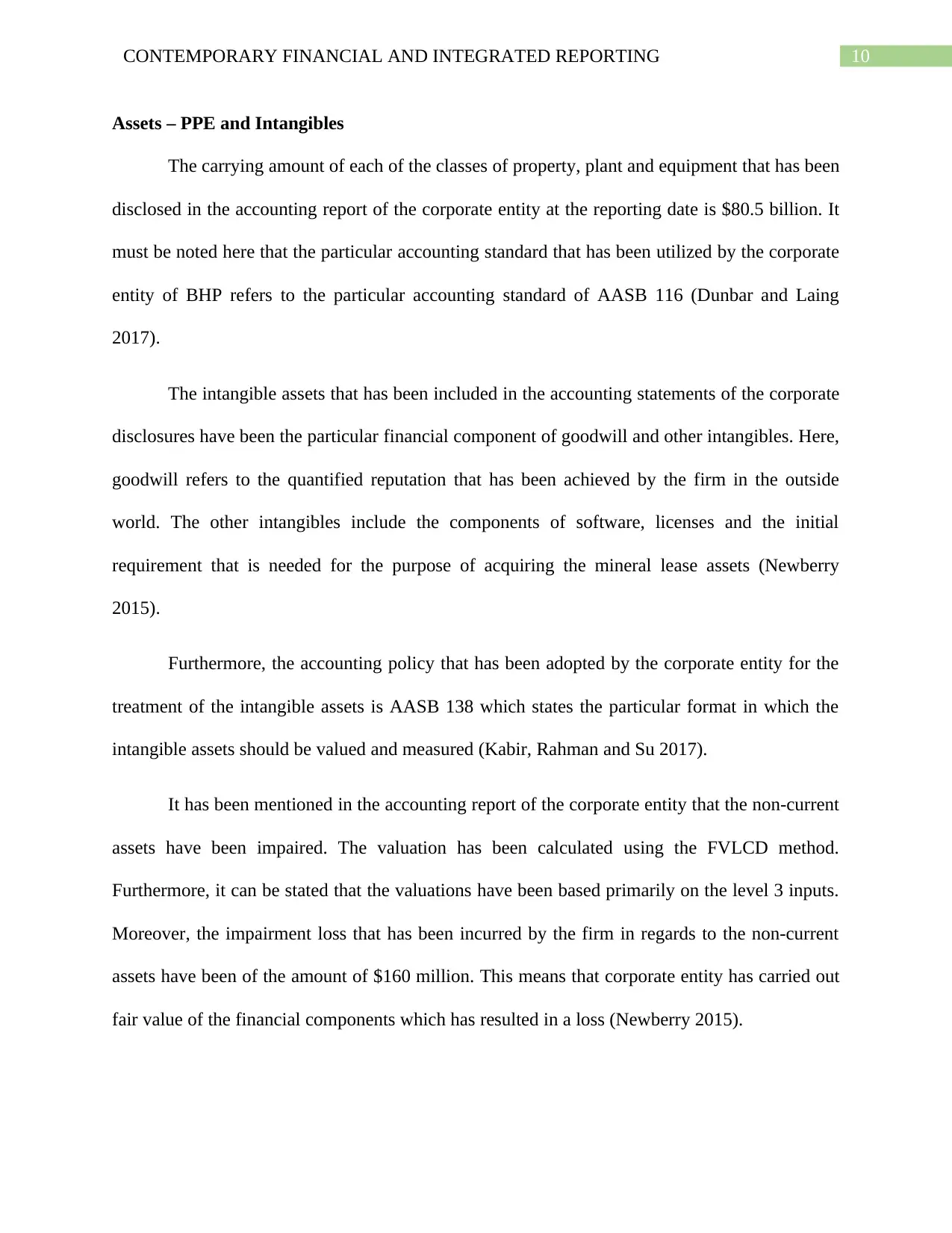
10CONTEMPORARY FINANCIAL AND INTEGRATED REPORTING
Assets – PPE and Intangibles
The carrying amount of each of the classes of property, plant and equipment that has been
disclosed in the accounting report of the corporate entity at the reporting date is $80.5 billion. It
must be noted here that the particular accounting standard that has been utilized by the corporate
entity of BHP refers to the particular accounting standard of AASB 116 (Dunbar and Laing
2017).
The intangible assets that has been included in the accounting statements of the corporate
disclosures have been the particular financial component of goodwill and other intangibles. Here,
goodwill refers to the quantified reputation that has been achieved by the firm in the outside
world. The other intangibles include the components of software, licenses and the initial
requirement that is needed for the purpose of acquiring the mineral lease assets (Newberry
2015).
Furthermore, the accounting policy that has been adopted by the corporate entity for the
treatment of the intangible assets is AASB 138 which states the particular format in which the
intangible assets should be valued and measured (Kabir, Rahman and Su 2017).
It has been mentioned in the accounting report of the corporate entity that the non-current
assets have been impaired. The valuation has been calculated using the FVLCD method.
Furthermore, it can be stated that the valuations have been based primarily on the level 3 inputs.
Moreover, the impairment loss that has been incurred by the firm in regards to the non-current
assets have been of the amount of $160 million. This means that corporate entity has carried out
fair value of the financial components which has resulted in a loss (Newberry 2015).
Assets – PPE and Intangibles
The carrying amount of each of the classes of property, plant and equipment that has been
disclosed in the accounting report of the corporate entity at the reporting date is $80.5 billion. It
must be noted here that the particular accounting standard that has been utilized by the corporate
entity of BHP refers to the particular accounting standard of AASB 116 (Dunbar and Laing
2017).
The intangible assets that has been included in the accounting statements of the corporate
disclosures have been the particular financial component of goodwill and other intangibles. Here,
goodwill refers to the quantified reputation that has been achieved by the firm in the outside
world. The other intangibles include the components of software, licenses and the initial
requirement that is needed for the purpose of acquiring the mineral lease assets (Newberry
2015).
Furthermore, the accounting policy that has been adopted by the corporate entity for the
treatment of the intangible assets is AASB 138 which states the particular format in which the
intangible assets should be valued and measured (Kabir, Rahman and Su 2017).
It has been mentioned in the accounting report of the corporate entity that the non-current
assets have been impaired. The valuation has been calculated using the FVLCD method.
Furthermore, it can be stated that the valuations have been based primarily on the level 3 inputs.
Moreover, the impairment loss that has been incurred by the firm in regards to the non-current
assets have been of the amount of $160 million. This means that corporate entity has carried out
fair value of the financial components which has resulted in a loss (Newberry 2015).
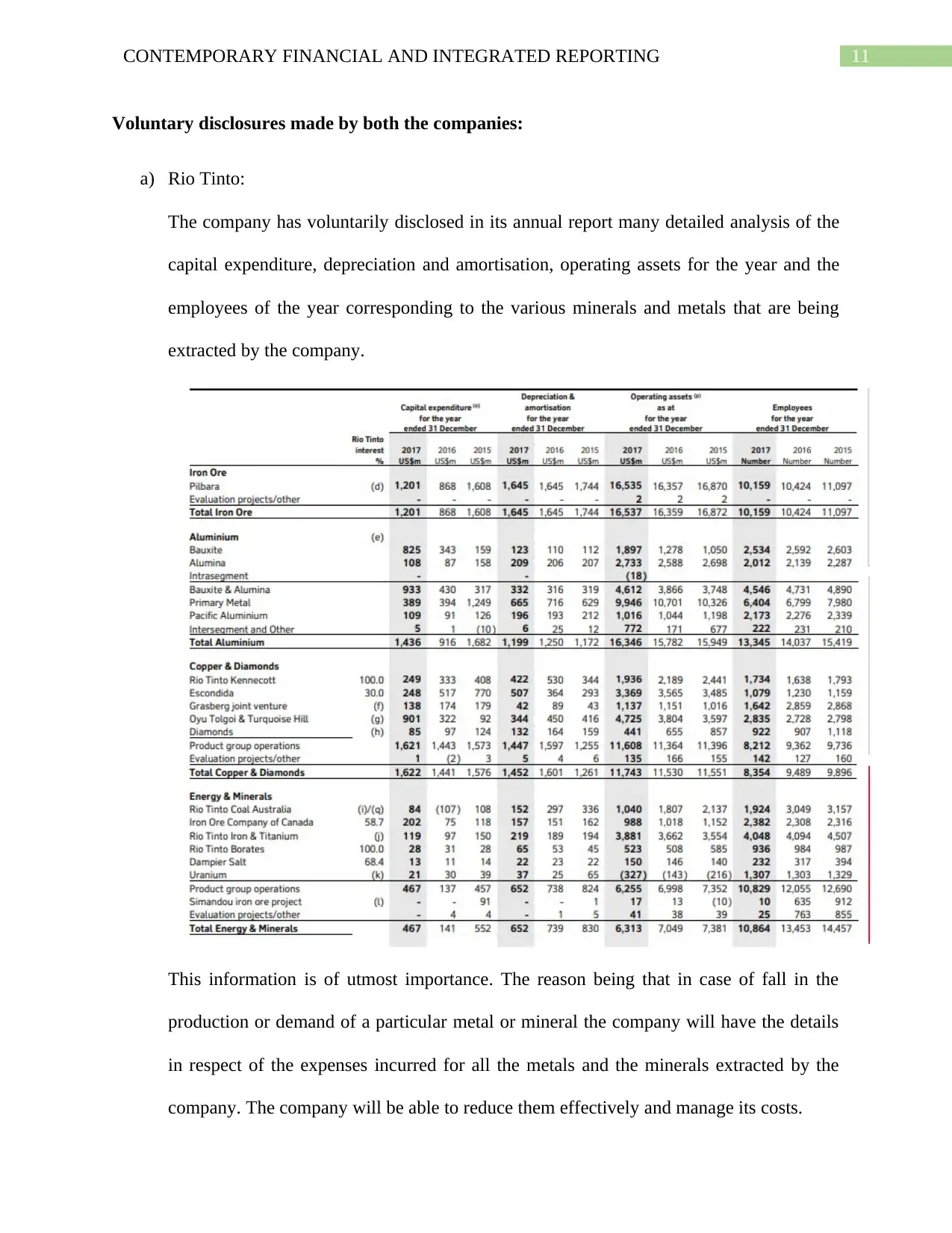
11CONTEMPORARY FINANCIAL AND INTEGRATED REPORTING
Voluntary disclosures made by both the companies:
a) Rio Tinto:
The company has voluntarily disclosed in its annual report many detailed analysis of the
capital expenditure, depreciation and amortisation, operating assets for the year and the
employees of the year corresponding to the various minerals and metals that are being
extracted by the company.
This information is of utmost importance. The reason being that in case of fall in the
production or demand of a particular metal or mineral the company will have the details
in respect of the expenses incurred for all the metals and the minerals extracted by the
company. The company will be able to reduce them effectively and manage its costs.
Voluntary disclosures made by both the companies:
a) Rio Tinto:
The company has voluntarily disclosed in its annual report many detailed analysis of the
capital expenditure, depreciation and amortisation, operating assets for the year and the
employees of the year corresponding to the various minerals and metals that are being
extracted by the company.
This information is of utmost importance. The reason being that in case of fall in the
production or demand of a particular metal or mineral the company will have the details
in respect of the expenses incurred for all the metals and the minerals extracted by the
company. The company will be able to reduce them effectively and manage its costs.
⊘ This is a preview!⊘
Do you want full access?
Subscribe today to unlock all pages.

Trusted by 1+ million students worldwide
1 out of 18
Related Documents
Your All-in-One AI-Powered Toolkit for Academic Success.
+13062052269
info@desklib.com
Available 24*7 on WhatsApp / Email
![[object Object]](/_next/static/media/star-bottom.7253800d.svg)
Unlock your academic potential
Copyright © 2020–2025 A2Z Services. All Rights Reserved. Developed and managed by ZUCOL.





